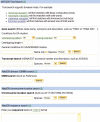NATsDB: Natural Antisense Transcripts DataBase
- PMID: 17082204
- PMCID: PMC1635336
- DOI: 10.1093/nar/gkl782
NATsDB: Natural Antisense Transcripts DataBase
Abstract
Natural antisense transcripts (NATs) are reverse complementary at least in part to the sequences of other endogenous sense transcripts. Most NATs are transcribed from opposite strands of their sense partners. They regulate sense genes at multiple levels and are implicated in various diseases. Using an improved whole-genome computational pipeline, we identified abundant cis-encoded exon-overlapping sense-antisense (SA) gene pairs in human (7356), mouse (6806), fly (1554), and eight other eukaryotic species (total 6534). We developed NATsDB (Natural Antisense Transcripts DataBase, http://natsdb.cbi.pku.edu.cn/) to enable efficient browsing, searching and downloading of this currently most comprehensive collection of SA genes, grouped into six classes based on their overlapping patterns. NATsDB also includes non-exon-overlapping bidirectional (NOB) genes and non-bidirectional (NBD) genes. To facilitate the study of functions, regulations and possible pathological implications, NATsDB includes extensive information about gene structures, poly(A) signals and tails, phastCons conservation, homologues in other species, repeat elements, expressed sequence tag (EST) expression profiles and OMIM disease association. NATsDB supports interactive graphical display of the alignment of all supporting EST and mRNA transcripts of the SA and NOB genes to the genomic loci. It supports advanced search by species, gene name, sequence accession number, chromosome location, coding potential, OMIM association and sequence similarity.
Figures




Similar articles
-
Genome-wide in silico identification and analysis of cis natural antisense transcripts (cis-NATs) in ten species.Nucleic Acids Res. 2006 Jul 18;34(12):3465-75. doi: 10.1093/nar/gkl473. Print 2006. Nucleic Acids Res. 2006. PMID: 16849434 Free PMC article.
-
Small RNAs and the regulation of cis-natural antisense transcripts in Arabidopsis.BMC Mol Biol. 2008 Jan 14;9:6. doi: 10.1186/1471-2199-9-6. BMC Mol Biol. 2008. PMID: 18194570 Free PMC article.
-
Trans-natural antisense transcripts including noncoding RNAs in 10 species: implications for expression regulation.Nucleic Acids Res. 2008 Sep;36(15):4833-44. doi: 10.1093/nar/gkn470. Epub 2008 Jul 24. Nucleic Acids Res. 2008. PMID: 18653530 Free PMC article.
-
Regulation of inducible gene expression by natural antisense transcripts.Front Biosci (Landmark Ed). 2012 Jan 1;17(3):938-58. doi: 10.2741/3965. Front Biosci (Landmark Ed). 2012. PMID: 22201782 Review.
-
Natural antisense transcripts regulate gene expression in an epigenetic manner.Biochem Biophys Res Commun. 2010 May 28;396(2):177-81. doi: 10.1016/j.bbrc.2010.04.147. Epub 2010 May 8. Biochem Biophys Res Commun. 2010. PMID: 20438699 Review.
Cited by
-
Bidirectional regulation between WDR83 and its natural antisense transcript DHPS in gastric cancer.Cell Res. 2012 Sep;22(9):1374-89. doi: 10.1038/cr.2012.57. Epub 2012 Apr 10. Cell Res. 2012. PMID: 22491477 Free PMC article.
-
antiCODE: a natural sense-antisense transcripts database.BMC Bioinformatics. 2007 Aug 30;8:319. doi: 10.1186/1471-2105-8-319. BMC Bioinformatics. 2007. PMID: 17760969 Free PMC article.
-
Asymmetric localization of natural antisense RNA of neuropeptide sensorin in Aplysia sensory neurons during aging and activity.Front Genet. 2014 Apr 22;5:84. doi: 10.3389/fgene.2014.00084. eCollection 2014. Front Genet. 2014. PMID: 24795747 Free PMC article.
-
The Emerging Role of Non-Coding RNAs in Drug Addiction.Front Genet. 2012 Jun 22;3:106. doi: 10.3389/fgene.2012.00106. eCollection 2012. Front Genet. 2012. PMID: 22737160 Free PMC article.
-
Genome-wide identification, characterization, and expression analysis of lineage-specific genes within zebrafish.BMC Genomics. 2013 Jan 31;14:65. doi: 10.1186/1471-2164-14-65. BMC Genomics. 2013. PMID: 23368736 Free PMC article.
References
-
- Wagner E.G., Simons R.W. Antisense RNA control in bacteria, phages, and plasmids. Annu. Rev. Microbiol. 1994;48:713–742. - PubMed
-
- Rogozin I.B., Spiridonov A.N., Sorokin A.V., Wolf Y.I., Jordan I.K., Tatusov R.L., Koonin E.V. Purifying and directional selection in overlapping prokaryotic genes. Trends Genet. 2002;18:228–232. - PubMed
-
- Vanhee-Brossollet C., Vaquero C. Do natural antisense transcripts make sense in eukaryotes? Gene. 1998;211:1–9. - PubMed
-
- Carmichael G.G. Antisense starts making more sense. Nat. Biotechnol. 2003;21:371–372. - PubMed
Publication types
MeSH terms
Substances
Associated data
- Actions
Grants and funding
LinkOut - more resources
Full Text Sources
Other Literature Sources
Research Materials

